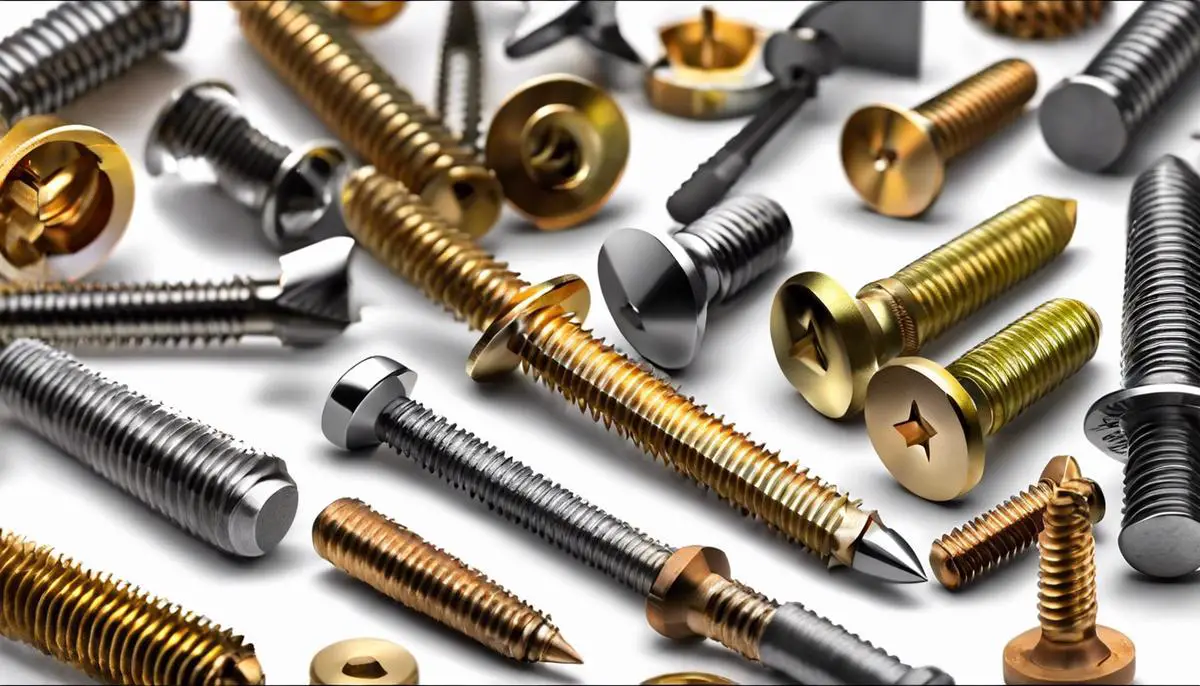At first glance, the humble screw may appear to be a simple and ubiquitous component of everyday life, but beneath its unassuming exterior lies a complex legacy of innovation and specialization. The story of the screw is one of evolutionary excellence, mirroring the arc of human development and ingenuity. From the wooden screws of the ancient world to the highly engineered fasteners of the twenty-first century, each twist and turn in the screw’s design is a testament to our relentless pursuit of improvement and precision. This essay seeks to unravel the intricate tapestry of the screw’s history, exploring the myriad types that have been shaped by the dual forces of function and technology across centuries of progress.
Historical Development of Screw Types
The Evolution of Screw Types: Insights from Historical Context
In examining the pivotal role that screws play in the realm of mechanical fastening, one must consider the historical progression that has led to the diverse array of screw types at our disposal today.
At its inception, the screw was a rudimentary tool, conceived by the ancient Greeks and fully realized during the first century B.C. by Archimedes. This early screw was not employed as a fastener but rather as a device for transferring water, known aptly as the Archimedes Screw—a testament to its utilitarian origins. It was characterized by a helical surface wound around a cylinder, an archetype that is fundamental to all screw designs.
The transition to the screw’s modern function as a fastener likely occurred during the Middle Ages. Metal screws used in armor and machinery began to emerge, though they were painstakingly fashioned by hand. This early craftsmanship accounts for a lack of standardization, where each screw and its corresponding threaded hole were unique, resulting in limited application and practicality.
The Industrial Revolution marked a turning point in screw production. Innovations in manufacturing gave rise to precision machinery, such as Jesse Ramsden’s screw-cutting lathe in the late 18th century. This allowed for greater uniformity and consistency in screw threads. Subsequently, the 19th century saw a burgeoning of standard thread systems like the Unified Thread Standard and the British Standard Whitworth. Such standardization was crucial for mass production and industrial scalability, paving the way for screws to become ubiquitous components in machinery and construction.
Today, the variety of screw types is astonishing, each serving a specialized function. For instance, the wood screw features sharp threads and a pointed tip designed for securing wood, while sheet metal screws have threads that are uniquely suited for metal substrates. Self-tapping screws can create their own threads within the material, offering convenience and efficiency. The Phillips head screw, with its cross-shaped slot, was developed to provide better grip for the screwdriver, while the Allen or hex screw, characterized by a hexagonal recess, offers a different approach to torque application.
Throughout its evolution, the development of the screw has been fundamentally shaped by the material requirements, technological advancements, and the drive for production efficiency. Each innovation in screw design was precipitated by the demands of the time, reflecting a response to the growing necessity for reliable and rapid assembly.
The screw is a prime example of how simple yet profound engineering solutions arise from the confluence of historical context and human ingenuity. As such, the study of its evolution serves not only to understand the past but also to inspire future design elements that anticipate the needs of tomorrow’s construction and manufacturing challenges. This demonstrates the importance of historical perspective in the iterative process of technological advancement, an endeavor that has far-reaching implications for the future of engineering and applied sciences.

Photo by iantalmacs on Unsplash
Functional Specialization of Screws
Diversity in screw design is a paramount aspect when considering the engineering and application of fasteners in various fields. With the foundation established, noting the intricate history and development of the screw, attention must now turn to the rationale for the existence of an array of screws each tailored to specific purposes.
The principle behind specialized screw design lies inherently in the diversity of materials and the distinctive scenarios in which they are utilized. Different materials exhibit varied properties such as density, resilience, and potential for splitting or cracking. Hence, a single type of screw would be insufficient to address all these requirements effectively. For instance, wood screws are uniquely designed with sharp, coarse threads to grip the fibrous structure of wood, enabling a strong bond. Conversely, metal screws possess finer threads and are often machine-crafted to mate with pre-tapped holes, fostering precise assemblies.
Furthermore, environmental considerations heavily influence screw design. Screws used in outdoor settings must demonstrate resistance to weathering, oxidation, and corrosion. Stainless steel or coated screws are the result of such considerations, ensuring longevity and integrity even under harsh conditions.
The mechanical demands of a screw also dictate its design. Structural screws, for example, are engineered to withstand heavy loads and are therefore robust, with high tensile strength ratings. Moreover, advancements in technology have introduced screws with engineered threads that can cut into materials, eliminating the need for drilling pilot holes, thus enhancing efficiency.
Ergonomics is another driving factor in the evolution of screw designs. The heads of screws, whether Phillips, Robertson, hex, or Torx, are adapted to specific tools and applications, allowing optimal transfer of torque from the tool to the fastener with minimal risk of cam-out or damage.
Lastly, the inception of electronic devices and delicate machinery necessitates screws of minute dimensions with incredibly precise threads – a far cry from their medieval ancestors. This represents not merely a scaling of size but a reinvention of the tolerances and strengths required for such meticulous applications.
In conclusion, the design of screws is an epitomic reflection of functional necessity imposed by material properties, environmental conditions, mechanical demands, ergonomics, and the ceaseless march of technological innovation. These factors coalesce to birth screws of various calibers, indelibly serving the myriad sectors reliant on these seemingly simple yet profoundly sophisticated instruments of construction and manufacturing.

Impact of Industry Standards on Screws
The profusion of screw types today, beyond serving the mere act of fastening, symbolizes the interplay between industrial standards and human ingenuity. The interaction between these standards and the myriad of screw types is an intricate dance of functionality, efficiency, and innovation.
Industrial standards have played a pivotal role in the unification of screw types. By establishing clear parameters for thread pitch, the angle of the thread, and overall geometry, standards have paved the way for mass production and interoperability among components from different manufacturers. This solidarity in design ensures that a screw purchased in one part of the world can fit into materials or components manufactured thousands of miles away.
Moreover, the establishment of specific standards has catalyzed the diversification of screw types. Each standard delineates a particular range of characteristics suitable for specific conditions. For instance, screws crafted to resist corrosion, such as those made with stainless steel, meet stringent standards that guarantee longevity in harsh environmental conditions. Alternatively, standards for high-tensile screws ensure that structural components hold steadfast under extreme loads.
The drive for precision has resulted in the proliferation of drive types. The cross-head (Phillips) and hexagonal (Allen) drives are just two manifestations of a world where the user’s ability to apply torque and avoid cam-out is crucial. Each drive design mitigates particular operation issues and maximizes efficiency, leading to faster assembly times and reduced fatigue for technicians.
In the realm of electronics, miniature screws reflect the influence of standards that demand compact design without sacrificing reliability. As components shrink, so too must the screws that hold them together, compelling engineers to devise screws with delicate threads capable of high precision. The rise of portable devices has necessitated screws that not only meet these size constraints but do so with a tensile strength that can withstand the rigors of daily use.
Continual advancements in manufacturing techniques have further expanded the possibilities for screw types. The advent of additive manufacturing has introduced complex geometries that were once impossible to create. Such innovation allows for the design of custom screws with unique properties, pushing forward the boundaries of what was once perceived as a simple fastener into the realm of high-performance components.
In conclusion, the vast array of screw types is emblematic of an adaptive and responsive industry guided by evolving standards. This dynamic relationship between standards and screw types is reflective of broader economic, environmental, and industrial trends that shape our day-to-day lives. By facilitating compatibility and encouraging precision and efficiency, standards are not simply guidelines—they are catalysts for creativity and excellence in the fastening domain.

Future Trends in Screw Design
Recent advancements in screw design continue to reshape our approach to construction and manufacturing, with continued focus on precision, efficiency, and application specificity. Contemporary innovation is heavily influenced by the desire for decreased waste and increased reliability in screws, which are integral to an array of mechanical assemblies.
A leading edge in screw design is the implementation of industrial standards, which provide a bedrock upon which manufacturing consistency and product interoperability rely. By identifying optimal thread pitch, angle, and overall geometry, these standards have allowed for screws to be integrated seamlessly across various products and projects.
Moreover, these agreed-upon parameters have enabled mass production with an assurance of compatibility, resulting in reduced costs and increased accessibility. This standardization, however, stands not as a barrier but as a conduit to diversity. It simultaneously prompts designers to tailor screws to specialized conditions—an exemplar being designs that exhibit superior resistance to environmental degradation or those adept at handling extraordinary loads.
The evolution of drive types constitutes another pivotal aspect of screw design. The interface between screw and tool directly affects torque transmission and the prevalence of cam-out. Alternative drive types have been developed to improve the engagement of driver bits with the screw head, enabling the application of greater torque without slippage, thereby enhancing the assembly process and reducing wear.
In the realm of electronics and precision machinery, where spatial constraints are paramount, the demand for miniature screws has magnified. These diminutive components are designed for compactness, requiring meticulous manufacturing practices to ensure their functionality and strength, despite their reduced size.
On the production frontier, the introduction of additive manufacturing, more commonly known as 3D printing, has facilitated the creation of custom screws with unique geometries and properties, tailored for specific applications that deviate from the norm. The ability to prototype and produce specialized screws rapidly is revolutionizing the field, providing engineers with greater flexibility.
The dynamic interplay between universal standards and the continual innovation in screw types captures the essence of industrial progress. The development of new materials, manufacturing methods, and geometric designs reflects the industry’s responsiveness to a world that demands agility and steadfastness from even the most minute of components—the humble screw.

The journey through the labyrinth of screw design reveals the extraordinary lengths we go to refine and adapt even the smallest components to the towering demands of human industry and innovation. Screws may not dominate headlines, but they hold our world together, both literally and metaphorically. As we continue to advance into uncharted territories of material science and manufacturing capabilities, the threads that bind the story of the screw will undoubtedly grow in complexity. Yet, the essence will remain the same: to connect, to build, and to enable the endless possibilities of creation.


Leave a Reply